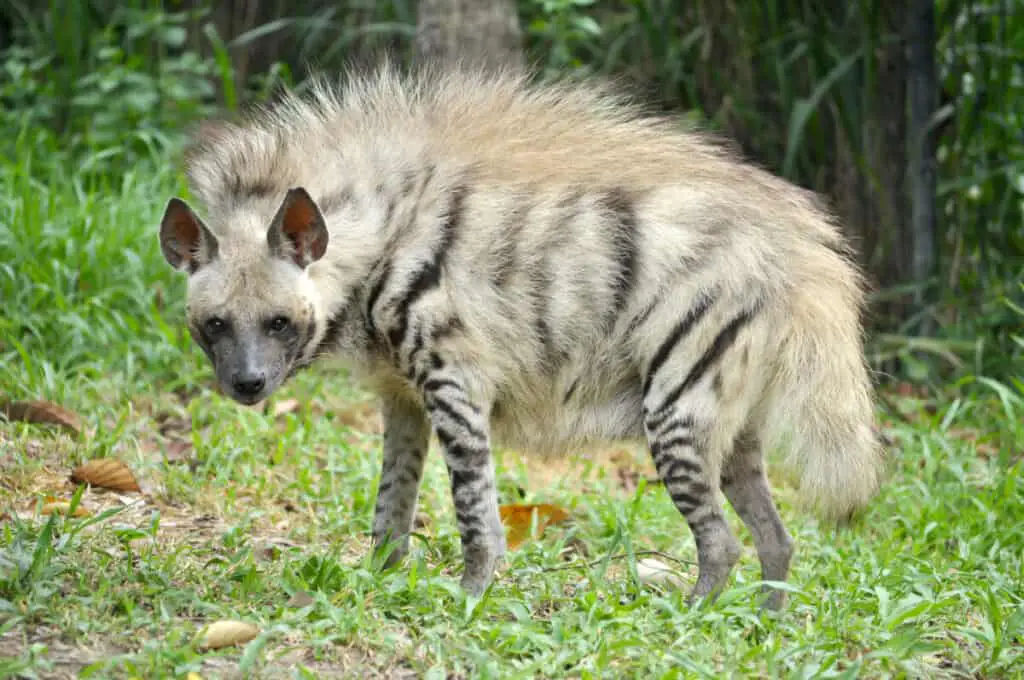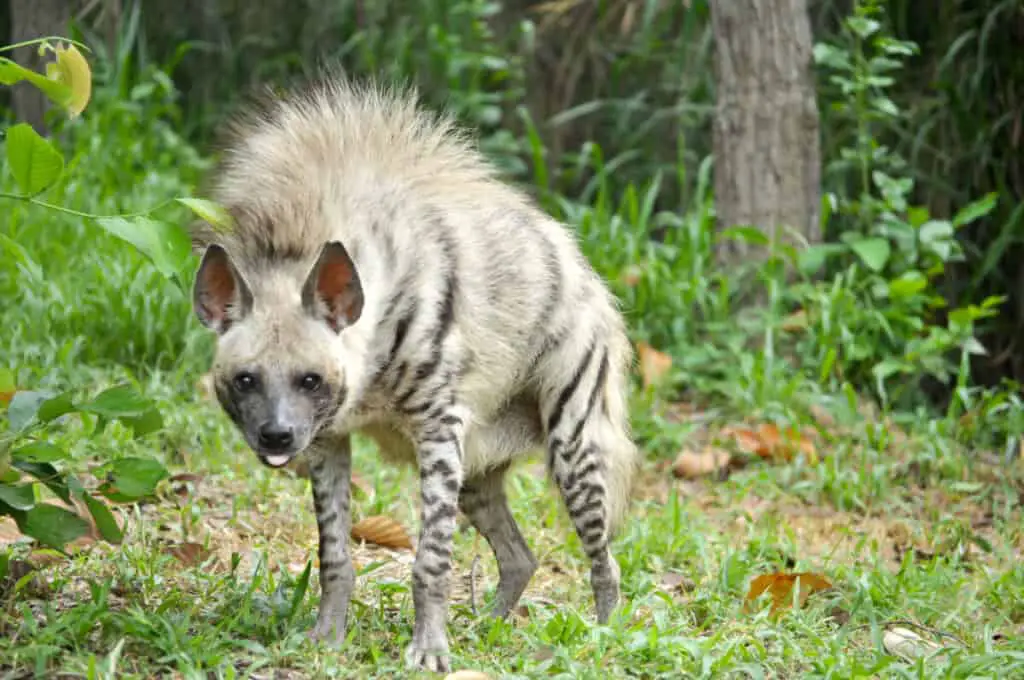The Striped Hyena (Hyaena hyaena) is a medium-sized carnivore found in parts of Africa, the Middle East, and southern Asia. This species is one of four extant species of hyenas and is known for its distinctive striped coat pattern and scavenging behavior.
Despite being widespread throughout much of its range, the Striped Hyena has been largely overlooked by researchers and conservationists alike. In recent years, however, there has been an increased interest in studying this enigmatic species due to its important ecological role as a top predator and carrion consumer.
Additionally, threats such as habitat loss, persecution from humans, and disease outbreaks have highlighted the need for further research into the biology and ecology of this fascinating animal.

Habitat And Range
The striped hyena, a medium-sized carnivorous mammal, is known for its distinctive black and white stripes that run down the length of its body. These markings provide excellent camouflage against the sandy and rocky landscapes in which they inhabit.
They have an extensive geographical distribution throughout North Africa, the Middle East, Central Asia, and parts of India. Their ability to adapt to arid environments has enabled them to survive in semi-deserts, savannas, and thorn scrub forests.
Striped hyenas also possess strong jaws capable of crushing bones, allowing them to scavenge on carcasses left behind by other predators. Additionally, their keen sense of smell and hearing allows them to locate prey effectively at night when they are most active.
All these adaptations make striped hyenas one of nature’s most resilient creatures able to withstand extreme conditions while still thriving in their natural habitat without any human intervention necessary.
Physical Characteristics And Behavior
The striped hyena’s habitat and range are diverse, as they can be found in a variety of environments ranging from deserts to forests. These animals have been observed living in mountainous regions, savannas, and even near human settlements. Their range spans across parts of Africa, the Middle East, and Asia.
When it comes to reproductive cycles, female striped hyenas only give birth once a year after a gestation period that lasts for around 90-100 days. Litters typically consist of two to four cubs with an average lifespan of up to twelve years.
Striped hyenas live in social groups known as clans which can include up to eighty individuals. These groups exhibit complex social interactions such as hierarchical structures where dominant females often lead their clan on hunts or protect their territory against outside threats. Additionally, these animals also communicate using various vocalizations such as growls and howls to alert other members of their clan about potential dangers or food sources nearby.
Diet And Feeding Habits
The diet and feeding habits of the striped hyena are diverse, as they are omnivorous creatures that eat both plant and animal matter.
Their prey preferences vary depending on their location, but in general, they hunt small to medium-sized animals such as rodents, reptiles, birds, insects, and carrion. They have also been known to scavenge from human settlements or garbage dumps.
Striped hyenas use a variety of hunting strategies to catch their prey. They are opportunistic hunters who will take advantage of any available food source.
In some areas, striped hyenas dig up dens where smaller mammals live and wait for them to come out at night. They also use their keen sense of smell to locate carrion left by other predators or humans.
When hunting larger prey like antelopes or gazelles, striped hyenas work together in packs to chase down their target using their powerful jaws and sharp teeth.
Overall, the striped hyena’s ability to adapt its diet and hunting strategies make it an efficient predator in many different environments.
As seen through the analysis above, the striped hyena exhibits a wide range of dietary behaviors while employing various hunting techniques unique to each type of prey hunted.
The utilization of these methods ensures this scavenger is capable of subsisting within multiple ecosystems throughout its habitat range without competition with others species present there too.
Ecological Importance
The striped hyena, despite being often overlooked or misunderstood in its role in ecosystems, plays a crucial part as a scavenger and predator. These animals play an important ecological function by consuming carrion from deceased animals that would otherwise accumulate and pose health risks to other organisms.
In addition, the presence of predators like the striped hyena can help control population dynamics of prey species through predation and competition.
Furthermore, studies have shown that the striped hyena’s ability to consume bones allows them to access nutrients not available to other species which contributes significantly to soil nutrient cycling.
Thus, the removal of these animals can result in significant changes in ecosystem structure and functioning. As such, conservation efforts should prioritize maintaining healthy populations of this species for their contribution towards overall ecosystem balance and resilience.
Conservation Status And Threats
As stated previously, the ecological importance of striped hyenas cannot be overstated. These scavengers play a crucial role in their ecosystems by consuming carrion and keeping populations of other animals in check. Additionally, they act as seed dispersers through their consumption of fruit.
However, despite their vital role, striped hyenas face numerous threats that have led to declining population trends. Habitat loss due to urbanization and agricultural expansion is one such threat, as well as human persecution due to superstitions and beliefs that hyenas are pests or dangerous predators. Furthermore, poaching for medicinal purposes and illegal hunting for meat or sport also contribute to their decline.
In response to these threats, protection measures have been put in place in various regions where striped hyenas are found. These include anti-poaching patrols, establishment of protected areas, education campaigns aimed at reducing negative attitudes towards the species, and community-based conservation efforts.
While these measures have seen some success in stabilizing populations in certain areas, continued efforts are necessary to ensure the survival of this important species.
Current Research And Future Directions
Current Research on the Striped Hyena
Recent research has been focused on using new technologies to better understand the behavior and ecology of striped hyenas.
GPS tracking collars have provided valuable data on their movements, ranging patterns, and home ranges.
In addition, camera traps have enabled researchers to capture images of these elusive animals and gather information about their social structure and interactions with other species in their habitat.
Another area of interest is collaboration opportunities among scientists across different regions where striped hyenas are found.
Researchers from various countries have been working together to share knowledge and coordinate efforts towards conservation initiatives for this species.
This includes developing effective communication strategies between local communities living near hyena populations and implementing measures to reduce human-wildlife conflicts that threaten their survival.
Future Directions for Striped Hyena Research
Looking ahead, there is a need for continued research on the population status, genetic diversity, and health of striped hyenas.
There are also opportunities for exploring innovative methods such as non-invasive sampling techniques to collect biological samples without disturbing or harming these animals.
Collaborative efforts can help address gaps in our understanding of this species’ natural history and support conservation management plans aimed at reducing threats like habitat loss, poaching, and persecution.
By combining new technologies with collaborative approaches, we can gain a more comprehensive picture of striped hyena biology while also promoting greater awareness about its ecological role within ecosystems it inhabits.

Conclusion
The striped hyena is a fascinating and elusive predator that inhabits arid regions of North Africa, the Middle East, and parts of Asia. These animals are known for their distinctive appearance, with long shaggy hair and bold black stripes running down their sides.
Despite their reputation as scavengers, striped hyenas are skilled hunters and capable predators in their own right. They possess strong jaws and sharp teeth, which they use to take down prey ranging from small rodents to larger herbivores like antelopes and gazelles.
As human populations continue to expand into wild areas, however, striped hyenas face numerous threats including habitat loss, persecution by farmers and herders, and poaching for body parts used in traditional medicine.
Conservation efforts aimed at protecting these unique animals are underway but will require continued research and public education if we hope to ensure their survival in the years ahead.
In conclusion, the striped hyena remains an enigmatic creature whose role in its ecosystem is not fully understood. Despite this mystery surrounding them, there is no doubt that these creatures play an important ecological role across their range.
As we learn more about them through scientific study and conservation efforts aimed at mitigating human-wildlife conflict, it is our responsibility to protect these remarkable creatures for future generations to enjoy.

